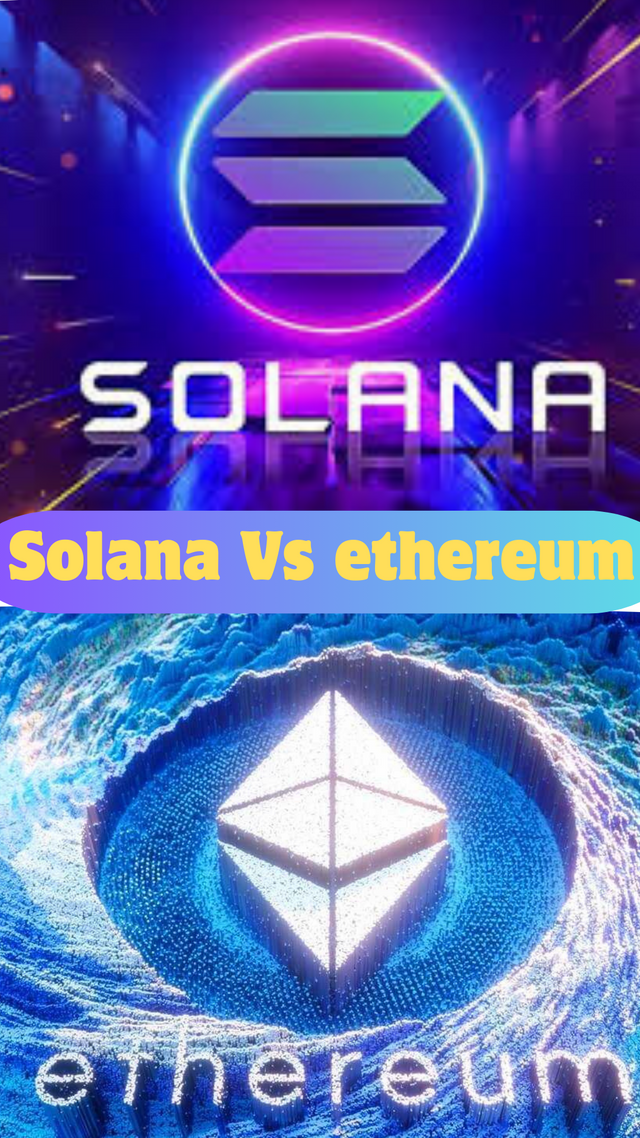
Welcome to our deep-dive analysis of two of the most popular coins in the cryptocurrency world: Solana and Ethereum. In this article, we will explore the benefits of Solana and the advantages of Ethereum, comparing their blockchain technology, smart contracts, scalability, decentralization, transaction speed, and more. Whether you're a crypto enthusiast or looking to invest, this analysis will help you make an informed decision.
Solana Vs Ethereum: A Deep-Dive Analysis of Two Popular Coins
Create an abstract representation of Solana and Ethereum competing against each other. Use contrasting colors, shapes, and patterns to depict the differences between the two popular coins. Show how they are both strong contenders in the world of cryptocurrency, but with distinct characteristics that set them apart from each other. Without using any textual elements, create an image that conveys the idea of a friendly rivalry between Solana and Ethereum.
Before we delve into the details, let's briefly discuss why these two coins have gained such popularity. Solana was designed to address the issues faced by Ethereum, such as low speeds and high transaction costs. On the other hand, Ethereum has a larger user base and market cap, making it a prominent player in the crypto space.
Market Cap and Technology
Ethereum and Solana, two prominent blockchain networks, differ not only in their market cap but also in their underlying technology. While Ethereum boasts a market cap of approximately $143 billion, making it the second-most-popular cryptocurrency after Bitcoin, Solana has a market cap of around $4 billion, positioning it among the top 10 cryptocurrencies.
What sets these two platforms apart is their approach to sustainable and innovative technology. Ethereum has transitioned to a more sustainable proof-of-stake (PoS) system, reducing its environmental impact compared to the energy-intensive proof-of-work (PoW) mechanism previously used. On the other hand, Solana has adopted a fast and innovative technology called proof-of-history (PoH), which allows it to operate as one of the fastest blockchains in the industry.
Sustainable Technology
Ethereum's move to a proof-of-stake model addresses concerns regarding energy consumption and environmental sustainability. By shifting from proof-of-work, which requires miners to solve complex mathematical puzzles to validate transactions, to proof-of-stake, where validators are chosen based on the number of coins held, Ethereum significantly reduces its carbon footprint. This transition aligns with the growing global focus on sustainable blockchain solutions.
Fast and Innovative Technology
Solana's proof-of-history implementation sets it apart from other blockchain networks. Instead of relying on timestamps provided by validators, Solana utilizes cryptographic proofs to ensure accurate and tamper-proof ordering of transactions. This innovative approach results in lightning-fast transaction speeds and enhanced scalability, making Solana an attractive choice for decentralized applications (DApps) that require rapid processing of large volumes of data.
In summary, while Ethereum commands a higher market cap and has embraced sustainable technology through its transition to proof-of-stake, Solana's implementation of the fast and innovative proof-of-history mechanism offers impressive transaction speeds and scalability. These contrasting approaches demonstrate the ongoing evolution and diversity within the cryptocurrency landscape, providing developers and users with a range of options to suit their specific needs and preferences.
Market Cap and Technology Image
"Create an image depicting a competition between two powerful forces: one representing the massive market capitalization of Solana, with bold and striking colors; the other representing the innovative technology of Ethereum, with intricate and dynamic shapes. Show them locked in a fierce battle, with both sides equally matched and determined to come out on top."
Pricing and Transaction Fees
When comparing Ethereum and Solana, one important factor to consider is the pricing and transaction fees associated with each cryptocurrency. Ethereum, with its high market cap and popularity, is relatively expensive, with one ETH coin currently priced at around $1,200. On the other hand, Solana offers a more affordable option, with one SOL coin priced at approximately $12. This significant difference in price may make Solana more appealing to those looking for a cost-effective investment opportunity.
Transaction fees can also be a crucial consideration for cryptocurrency users. Ethereum's transaction fees are known for their volatility, ranging from less than $1 to as high as $70 per transaction. This unpredictability can sometimes make it difficult for users to estimate the costs associated with their transactions. In contrast, Solana offers consistent and low transaction fees, with each transaction costing only a fraction of a cent. This predictability and affordability can contribute to a more seamless user experience when using Solana for transactions.
In summary, Ethereum's pricing is higher compared to Solana, making it a more significant investment upfront. However, Solana offers consistent and affordable transaction fees, providing users with a more predictable cost structure. The choice between the two currencies will depend on individual priorities, investment goals, and the specific use case.
Table: Comparison of Pricing and Transaction Fees
Cryptocurrency Price per Coin Transaction Fees
Ethereum $1,200 Varies ($1 - $70)
Solana $12 Consistently low (fraction of a cent)
Source: Image
Why Choose Ethereum or Solana
Ethereum and Solana are both popular choices in the blockchain industry, each offering unique features and advantages. While Ethereum boasts greater popularity and a larger market cap, Solana stands out with its innovative technology and faster transaction speeds. Here are a few key reasons why you might choose one over the other:
Innovation and Technology
Solana is known for its focus on innovation, leveraging the proof-of-history mechanism to achieve faster transaction speeds and low fees. This technology sets Solana apart from Ethereum, making it an attractive option for users who prioritize speed and cost-effectiveness in their transactions. Ethereum, on the other hand, has a longer track record and a more established ecosystem, which may be appealing if you value stability and reliability.
Ethereum Improvements and Upgrades
Ethereum has been making significant improvements to enhance its scalability and transaction fees. The upcoming Ethereum merge, set to take place in 2022, is expected to address the issues of slow transaction speeds and high fees, making it a more competitive option in terms of transaction efficiency. These improvements make Ethereum an attractive choice for users who value a well-established platform with ongoing enhancements.
Transaction Speeds and Fees
If fast transaction speeds and low fees are a priority for you, Solana may be the preferred option. Solana's proof-of-history mechanism allows for quick and efficient transactions, with fees that are significantly lower compared to Ethereum. Conversely, while Ethereum has higher transaction fees and slower speeds currently, the anticipated upgrades and improvements are expected to bring it closer to Solana's speed and cost-effectiveness.
Ultimately, the choice between Ethereum and Solana will depend on your specific needs and preferences. Consider factors such as popularity, innovation, transaction speeds, fees, and the overall direction of each blockchain when making a decision. Both platforms have their merits and continue to play significant roles in the cryptocurrency landscape.
Solana vs Ethereum
Show two distinct and contrasting planets representing Solana and Ethereum, with an out-of-focus galaxy in the background to emphasize their global impact. Use different shades of blue-green for Solana and shades of yellow-orange for Ethereum, and a clear dividing line between the two planets to represent their distinct ecosystems. Include small icons on each planet to symbolize their unique features and characteristics, such as a rocket ship for Solana's fast transaction speeds and lightning bolt for Ethereum's smart contract capabilities. Make the planets appear equal in size to represent their equal importance in the crypto market.
Conclusion
In conclusion, both Solana and Ethereum offer unique features and advantages in the cryptocurrency space. Ethereum, with its larger market cap and established ecosystem, remains more popular among users. The ongoing improvements to enhance scalability and transaction fees through the upcoming Ethereum merge in 2022 further solidify its position.
On the other hand, Solana stands out with its innovative technology, faster transaction speeds, and lower fees. The implementation of proof-of-history has allowed Solana to operate as one of the fastest blockchains, providing users with a seamless experience.
Ultimately, the choice between Solana and Ethereum depends on your individual preferences, investment goals, and the specific use case you have in mind. If you prioritize popularity, scalability, and an extensive range of decentralized applications (Dapps), Ethereum may be the preferred option. However, if you value speed, low fees, and cutting-edge technology, Solana offers a compelling alternative.
As the blockchain industry continues to evolve, both Solana and Ethereum will play significant roles. Whether you choose Solana or Ethereum, it's important to conduct thorough research, assess your needs, and stay informed about the latest developments to make the most informed investment decisions in the exciting world of cryptocurrencies.
FAQ
What is the difference between Solana and Ethereum?
Solana and Ethereum are two popular blockchains with their own native cryptocurrencies. While both are similar in construction, Solana was designed to improve upon Ethereum by addressing issues of low speeds and high transaction costs.
Which cryptocurrency has a higher market cap?
Ethereum has a high market cap of about $143 billion, making it the second-most-popular cryptocurrency after Bitcoin. Solana, on the other hand, has a market cap of about $4 billion.
How do the transaction fees compare between Ethereum and Solana?
Ethereum transaction fees can be volatile, ranging from less than $1 to as high as $70. Solana, on the other hand, has consistently low transaction fees, with each transaction costing a fraction of a cent.
Why is Ethereum more popular?
Ethereum is more popular than Solana in terms of usership and market cap. It also has a larger number of decentralized applications (Dapps) running on its platform.
What are the advantages of Solana?
Solana offers faster transaction speeds, lower fees, and innovative technology due to its proof-of-history mechanism. It operates as one of the fastest blockchains.
What are the advantages of Ethereum?
Ethereum has a longer track record, a well-established ecosystem, and ongoing improvements to enhance its scalability and transaction fees.
Which cryptocurrency should I choose?
The choice between Solana and Ethereum depends on individual preferences, investment goals, and the specific use case. Both have their own unique features and advantages.
